
The Western Ghats, also known as the Sahyadri mountain range, is a mountain range that covers an area of 160,000 km2 (62,000 sq mi) in a stretch of 1,600 km (990 mi) parallel to the western coast of the Indian peninsula, traversing the states of Gujarat, Maharashtra, Goa, Karnataka, Kerala and Tamil Nadu. It is a UNESCO World Heritage Site and one of the 36 biodiversity hotspots in the world. It is sometimes called the Great Escarpment of India. It contains a very large proportion of the country's flora and fauna, many of which are endemic to this region. The Western Ghats are older than the Himalayas. They influence Indian monsoon weather patterns by intercepting the rain-laden monsoon winds that sweep in from the south-west during late summer. The range runs north to south along the western edge of the Deccan Plateau and separates the plateau from a narrow coastal plain called the Western Coastal Plains along the Arabian Sea. A total of 39 areas in the Western Ghats, including national parks, wildlife sanctuaries and reserve forests, were designated as world heritage sites in 2012 – twenty of them in Kerala, ten in Karnataka, six in Tamil Nadu and four in Maharashtra.
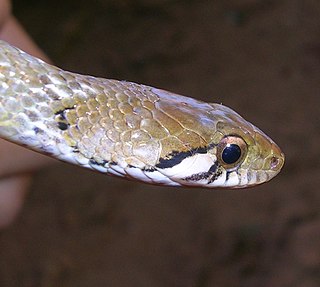
The Nilgiri keelback, also known commonly as Beddome's keelback, is a species of snake found in the Western Ghats in India. The species is named after Richard Henry Beddome, 1830–1911, British army officer and naturalist. It was first discovered near the Nilgiris but is now known more widely from the Western Ghats. This snake is terrestrial and feeds on toads.

Troides minos, the southern birdwing, also called Sahyadri birdwing, is a large and striking swallowtail butterfly endemic to South India. With a wingspan of 140–190 mm, it is the second largest butterfly of India. It is listed as Least Concern in the IUCN Red List.

Chandoli National Park is a national park established in Sangli district on May 2004. Earlier it was a Wildlife Sanctuary declared in 1985. Chandoli Park is notable as the southern portion of the Sahyadri Tiger Reserve, with Koyna Wildlife Sanctuary forming the northern part of the reserve

Gaganbawada is a town situated in the district of Kolhapur in Maharashtra, India. It is located 55 km by road from Kankavli. It is one of the taluka headquarters in Kolhapur district.

The striped keelback is a species of colubrid snake native to Indonesia. It has also been introduced to Singapore and Puerto Rico.
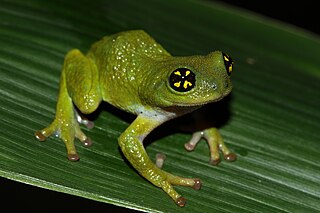
Raorchestes chalazodes is a species of critically endangered frog in the family Rhacophoridae. Raorchestes chalazodes is a nocturnal and arboreal species found in the understorey of tropical moist evergreen forest and is endemic to the Western Ghats of India. The specific name chalazodes is composed of the Greek word χάλαζα (chalaza) meaning "lump" and -odes for the derived adjective, reflecting white granulation of the body. It has been observed between 1200 and 1600 meters above sea level.

Raorchestes nerostagona is a species of frog in the family Rhacophoridae. It is endemic to the Western Ghats, India. It has been called as the Kalpetta yellow bush frog or lichen bush frog for its patchy lichen like patterning that make it cryptic. First described in 2005 based on a specimen obtained in Kalpetta, the species has subsequently been found in many parts of the Western Ghats. This frog has been observed between 900 and 1200 meters above sea level.
The Bombay swamp eel, also known as the paytop in Marathi, is a species of fish in the family Synbranchidae. It is endemic to the state of Maharashtra in India.
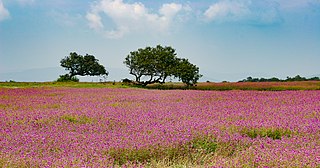
The Kas Plateau Reserved Forest, also known as the Kaas Pathar, is a plateau situated 25 kilometres west from Satara city in Maharashtra, India. It falls under the Sahyadri Sub Cluster of the Western Ghats, and it became a part of a UNESCO World Natural Heritage Site in 2012.
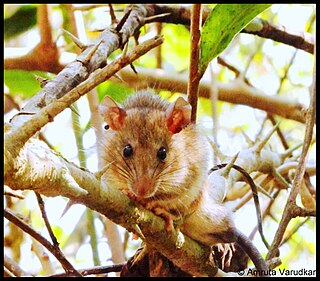
The Sahyadris forest rat is a species of rat belonging to the family Muridae. It is native to the northern Western Ghats in India where it is split between three regions, Satara in Maharashtra, the Nilgiri mountains in Tamil Nadu and Kodagu district in Karnataka.
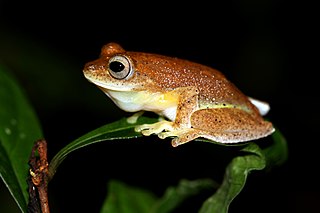
Mercurana is a genus of arboreal frogs belonging to the family Rhacophoridae. The genus was named from the only known species Mercurana myristicapalustris, which was described in 2013 from the Western Ghats of Kerala, India. The generic name was derived from and given as a tribute to Freddie Mercury, the late vocalist of the British rock band Queen, in combination with the Latin name for "frog". The frog is different from other related frogs in that it has extensively webbed toes, lives only in swampy lowlands, and lays its eggs on mud with which it carefully mixes leaf litter.

Beddomixalus is a monotypic genus of frogs in the family Rhacophoridae. The only described species, Beddomixalus bijui, is endemic to the Western Ghats, India. Its name is derived from a combination of the cognomen of Richard Henry Beddome, in honour of his work on the amphibian diversity of the Western Ghats, as well as Ixalus, which is often used as a suffix for names of rhacophorid genera.
Neoheterophrictus sahyadri is a spider species in the genus Neoheterophrictus. It was first described in 2012 by Manju Siliwal, Neha Gupta, and Robert John Raven. Its name "sahyadri" comes from the vernacular name for the Western Ghats, a mountain range in India where it was discovered.

Neoheterophrictus is a genus of tarantula in the family Theraphosidae. It comprises 8 species, all found in India.
Neoheterophrictus bhori is a species of tarantula. It is native to Parambiculam, Western Ghats, Cochin province, India, in present-day Kerala state.
Meotipa sahyadri is a spider species of the genus Meotipa that is mainly indigenous to the Western Ghats in India.

Echinops sahyadricus, the Sahyadri globe thistle, is a species of flowering plant. It is a medium sized forb belong to the tribe Cardueae in the family Asteraceae. E. sahyadricus was discovered by a Mumbai University student at the Rajgad Fort, and it was formally described in 2020.

Sahyadriophis is a genus of snakes in the family Colubridae. The genus is endemic to the Western Ghats of India.

Minervarya gomantaki, previously in the genus Fejervarya, is a species of frog, endemic to the Western Ghats region of India. It is also known as the Goan cricket frog or the Gomantak white lipped cricket Frog.
















